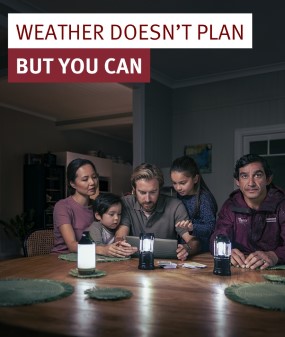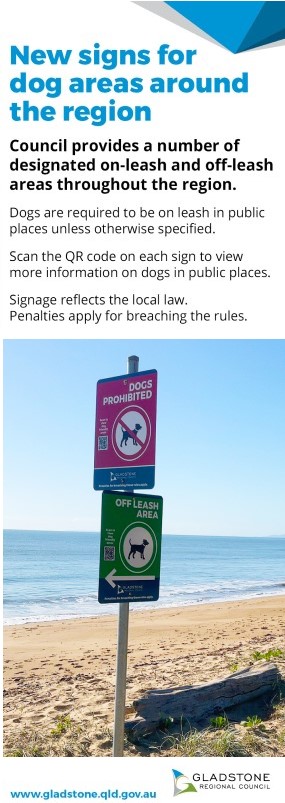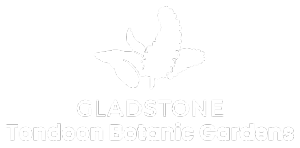Explore
Camping and Beaches
Swim safely
Understand the danger of swimming in Wild Cattle Creek at Tannum Sands.
Surf Life Saving Queensland and the Tannum Sands Surf Life Saving Club have some very important messages about swimming in Wild Cattle Creek.
Take a look at the video where an aquatic dye was released on an outgoing tide, demonstrating the dangerous rip, always present but often overlooked.
While the area looks like a safe and inviting place to swim, there is a strong underlying rip that can place you and your family in danger.
Remember, if lifeguards can't see you, they can't save you. Always swim between the flags.
Council offers several camping locations across our beautiful region.
Gladstone Harbour Islands
Workman's Beach, Agnes Water
Lilley's Beach, Boyne Island
Calliope River Picnic Area, River Ranch
Futter Creek Camping Reserve, Boynedale
Caravan chemical dump points
Generator use
Overall terms and conditions
- Strictly no fires. Please use a gas or kerosene stove
- Beach fires are strictly prohibited
- Wood fires can only be lit in authorised, Council maintained, wood-fired barbecues
- Place rubbish in bins, where provided. If no bins, take rubbish with you when leaving
- Low noise generators are permitted for use between 7am and 7pm
- Behaving in a riotous, disorderly, indecent, offensive, threatening or insulting manner will not be tolerated. Offenders will be requested to leave the camping ground and may incur a fine or permanent ban
- Be considerate of other campers by limiting noise between 10pm and 7am
- Interfering with a plant or any turf, sand, clay, soil or other material is prohibited. Penalties apply
- Interfering with any facility or equipment located at camping grounds is prohibited. Penalties apply
- Chemical toilet waste cannot be emptied in composting toilets or septic ablution blocks as the chemicals kill the organisms required for the effective operation of the composting/septic systems
- Chemical toilet waste must not be buried or disposed of in the sea or rivers
- Camp sites must be kept and maintained in good repair and clean, tidy and sanitary condition. The camping site must not be left unoccupied for more than two days. Council will remove and dispose of equipment from abandoned camp sites
- Where dogs are allowed - dogs must not cause a nuisance to others and it is the responsibility of their owners to clean up after them.
Gladstone Harbour Islands
Limited permits, allocation on a ‘first in’ basis
- The Oaks Camping Ground, Facing Island
- South End Camping Ground, Curtis Island
How to get a permit
- Book online for The Oaks Camping Ground, Facing Island
- Book online for South End Camping Ground, Curtis Island
- Visit the Gladstone Visitor Information Office, Bryan Jordan Drive (Marina complex), open seven days 8.30am-5pm weekdays and 9am-5pm weekends.
Fees (maximum of six people per camp site)
- Fees are set annual and are publised in the Fees and Charges booklet.
- No age restriction for camping on the islands but must be 18 years or older to book.
- Maximum of three sites per family – bookings up to 12 months in advance.
- Pay by cash, cheque or credit card. Bookings only confirmed when full payment received.
- ‘No Refund’ policy if a customer changes their mind, doesn’t attend on the booked dates, or misses the barge.
- Submit all booking refund requests to gladstonevicadmin@gapdl.com.au with a copy of the booking confirmation and reason for requesting a refund.
Facilities
Camp site maps available from GAPDL
- The Oaks – 32 camp sites
- South End – 20 camp sites
- Composting toilets at both campgrounds; cleaned regularly by caretakers on the island.
Site terms
- All overnight campers require a camping permit. Day visitors do not need a permit
- Maximum stay is 42 days. The area is regularly patrolled, and penalties apply for exceeding the maximum stay period
- No fires. No beach fires
- There is no potable water available on the island. Campers are to bring enough water supply for the duration of their stay.
- You may take a chemical toilet for short term stays but there are no chemical toilet waste disposal units on the islands
- Dogs must be on a lead or tethered at all times.
Workman's Beach, Agnes Water
Located off Springs Rd, Agnes Water, about 1km from Agnes Water township. The signed turn off to the camp is adjacent to the Agnes Water Skate Park; across 200m of dirt/sandy road.
Due to safety and security concerns and incidences of non-compliances with conditions for camping, we will not be accepting any further bookings for this camp ground. If you have any queries relating to this message, please contact us on (07) 4970 0700 during business hours.
Facilities
- Unisex and disabled toilets
- Cold water beach shower
- Picnic tables
- Free gas barbecues
- Bins provided
- No chemical toilet waste disposal units at the camp ground. Chemical toilets must be emptied at the designated dump point outside the Seventeen Seventy SES Grounds on Captain Cook Drive, Seventeen Seventy
- From the camp site there is a path leading down to an unpatrolled beach (about 200m) that is naturally steep and could be considered unsuitable for someone who is mobility impaired. The path requires a moderate level of fitness and users may encounter hazards such as slopes and unstable or uneven surfaces; users are responsible for their own safety.
Site terms
- All overnight campers require a camping permit. Day visitors do not need a permit
- 38 camp sites available for tents and caravans.
- Maximum stay is 14 days. The area is regularly patrolled, and penalties apply for exceeding the maximum stay period. Upon leaving return camping is not permitted for 7 days.
- No fires. No beach fires
- No vehicles permitted on Workman's Beach
- Use only established walking trails
- Dogs must be on a lead or tethered at all times.
Lilley's Beach, Boyne Island
Lilley's Beach is a sensitive foreshore area that extends along the coastline for approximately seven kilometres and is accessible by four-wheel drive only. Vehicle access to Lilley’s Beach is from the Boyne Island Sewerage Treatment Plant, via Handley Dr, Boyne Island.
Turtle nesting
Marine turtles nest in the sand dunes between November and March.
Do not drive or park above the high tide mark and only drive during daylight hours.
The best time to travel is at low tide or within two hours either side of low tide (tidal conditions).
Volunteers from the Fitzroy Basin Association’s Team Turtle CQ monitor the area annually for turtle nests from November to March.
More information on turtle nesting
Permits must be obtained before entering the access off Handley Drive, Boyne Island and whilst you are in the area, the Permit must be always carried within the vehicle and produced when asked for inspection by an Authorised Person/Officer.
Regular patrols are carried out by Gladstone Regional Council Officers and the Queensland Police Service to ensure that all vehicles in the area have a current permit on hand, and that people are abiding by the Conditions of the Permit and Queensland traffic rules. Penalties will apply for vehicles found in the area without a permit.
It is the permit holder’s responsibility to check the permit expiry date before travelling to ensure the permit is current. Please note Council does not issue permit reminder notices.
Weekly or annual permits can be purchased via Council’s Online Portal or in person at any Council office or the Boyne Tannum Community Centre.
To obtain a Permit you must provide the below information:
- Email address
Note: Permits are issued to your nominated email address as soon as your payment is processed. Please ensure that you enter your correct email address. - Vehicle make and model
- Vehicle body type
- Vehicle registration number
Note: Please enter the correct Vehicle Registration Number. Incorrect entry of your vehicles registration number may result in infringements being issued to the registered vehicle owner for “Failure to have the required permit to access Lilley’s Beach”. - Vehicle colour
Fees are set annually and are publised in the Fees and Charges booklet.
Permits are not transferrable to another person, however if a permit holder sells a vehicle that they hold a permit for and can provide proof of sale, a permit can be transferred to a different vehicle registration number of a vehicle they own.
A fee will apply to reissue a lost/misplaced permit.
The following vehicles are exempt from Permit Fees:
- Emergency vehicles
- Commonwealth, State, and Local Government vehicles (only when used for official purposes)
- Traditional owners are exempt from paying a fee for a vehicle access permit in the exercise of their native rights and interests
Applicants must meet the eligibility criteria. Please email Council your request to be exempt from permit fees.
As the site is basic, there are no facilities or rubbish bins. Please take all rubbish with you when you leave.
All vehicles entering and exiting Lilley’s Beach access may have their vehicle number plates recorded and those details matched against Council’s booking service. Those vehicles found entering without a current valid Lilley’s Beach Permit will be issued with a Penalty Infringement Notice (PIN). This amount increases each financial year from 1 July. To avoid the fine, please ensure that you have purchased a Lilley’s Beach Permit before entering and if you have a permit that it is valid. All camera footage obtained is stored securely and only viewed and accessed by authorised persons. Footage is retained for 30-90 days, unless it is required for official purposes. This is in accordance with the Public Records Act 2002. Find out more about Gladstone Regional Council’s Privacy Statement.
- Vehicles are PROHIBITED to drive on the foredunes above the high-water mark or on the tidal flats at any time.
- Vehicles are PROHIBITED to travel South towards the mouth of the Boyne River and are only permitted to travel north of the beach entrance.
- Motorbikes, trikes, trail bikes, and quadbikes are prohibited.
- Obey all road rules - All Queensland Road rules apply, even on beaches.
- The speed limit is 60 km/h.
- All vehicles must be registered.
- Wear seatbelts at all times.
- Keep left of oncoming vehicles at all times
- Pedestrians, cyclists, pets, and wildlife have the right of way.
- Use indicators only when overtaking or turning.
- All drivers must hold the appropriate driver's licence.
- Never sit outside the moving vehicle or tow people behind the vehicle - it is illegal and people have been seriously injured this way.
- Fires are prohibited.
- Dogs must be supervised and always under effective voice commands. They must not create a nuisance to other members of the public and wildlife or cause damage to the vegetation in the area.
- All rubbish must be taken when you leave.
- Do not undertake any activity that causes a nuisance, harms wildlife, or damages vegetation.
Be sea turtle friendly
Marine turtles are known to nest on Lilley’s Beach between November and March.
During the nesting process, the turtles are easily disturbed by lights, noise and movement.
Once a turtle has laid her eggs within the beach foredunes, the nest is incubated in the sand for approximately six weeks before the hatchlings emerge.
Nest disturbance and habitat destruction from human activities such as four wheel-driving and trampling are major threats to marine turtles. Only drive or walk on the beach below the high tide mark. Do not interfere with coastal plants and do not light beach fires.
Please dispose of your rubbish appropriately and keep dogs under effective command at all times.
Shorebirds
Shorebird feeding and roosting is linked to the tidal cycles. During low tides, shorebirds will be out feeding on the tidal flats and beaches. At high tide, the birds will be resting and digesting their food and are more susceptible to disturbances from vehicles and dogs. This is another reason to only drive on the beach within two hours on either side of the low tide and please keep your playful pooch under effective control.
Seagrass meadows
The tidal flats below the low tide mark at Lilley’s Beach provide a habitat for seagrass meadows. Seagrass meadows act as the kidneys of the Great Barrier Reef and filter out pollutants, minerals, nutrients and sediments. They also provide a habitat for invertebrates, fish, turtles and dugongs. Seagrass meadows are fragile and if damaged, they may take years to recover. Please do not drive below the low tide mark.
- Always carry a first-aid kit and sufficient food and water.
- Always supervise children.
- Bring insect repellent to avoid mosquito and sandfly bites.
- Lilley’s Beach is not a patrolled swimming area, do not swim in the ocean.
- Do not drive when you are tired or under the influence of alcohol or medication.
- You need to be constantly alert and familiar with sand driving techniques - 4WDs handle differently in sand.
- Police visit the island with speed detectors and breathalyser units.
- Ensure your vehicle is mechanically sound.
- Carry essential items such as water, tyre gauge, tyre pressure, pump, snatch strap, tow rope and a first-aid kit.
- Check that your tyre pressure gauge works.
- Be familiar with your vehicle and correct driving techniques.
- Plan your trip – it’s best to travel two hours either side of low tide. The beach can become impassable at high tide. If there’s not enough space to drive between the water and the dunes, then turn back and wait for the tide to go out.
- Pedestrians - they often cannot hear approaching vehicles above the sound of surf or strong winds. Slow down near people on the beach, especially around children.
- Seabirds and other wildlife—always go slow and go around flocks of birds.
- Other vehicles – please wait for them to pass. Do not attempt to pass by driving over vegetation or dunes.
- Engage locking hubs and only drive on the beach with a 4WD with high clearance and low range gear selection. Motorbikes, trikes, trail bikes, and quadbikes are prohibited.
- Ensure you are proficient in four-wheel-driving, if you are a novice, try driving with someone experienced in sand driving.
- Check the manufacturer’s tyre pressure recommendations for sand driving.
- Reduced tyre pressure within manufacturer's specifications helps maintain traction on inland tracks and soft sand. If you choose to reduce your tyre pressure, re-inflate your tyres again to resume speed on harder sand or mainland driving.
- Avoid sharp turns and sudden braking.
- Select low gears for soft, dry sand.
- If your vehicle bogs, reverse out and try to drive forward again.
- It is illegal to drive off-track on dunes.
- Avoid driving at night – hazards are extremely difficult to see at night.
- Don’t take risks – beach driving can be a lot of fun, but it can also be dangerous.
- Bookings can’t be modified on the same day they were made.
- Lilley’s Beach permits are not transferrable to other vehicles. The driver of the registered vehicle must ensure there is a current permit for the vehicle being driven onto Lilley's Beach.
- Modifications must be made prior to entry into Lilley’s Beach access.
- When making changes, ensure that your telephone number and email address are current so that we can contact you if needed.
- Permit fees are non-refundable.
- It is the permit holder’s responsibility to check the permit expiry date before traveling to ensure the permit is current. Please note Council does not issue permit reminder notices.
Calliope River Picnic Area, River Ranch
(Free rest area)
*** This free rest area is suitable for self-contained travellers only. ***
Calliope River Picnic Area is a low-maintenance rest area, located 26km west of Gladstone and 100km south of Rockhampton, beside the Calliope River.
- Visitors can set up camp above the river on the high, northern side or near the cleared area on the southern side.
- Camping is not recommended at the Calliope River Picnic Area if local flood warnings have been issued.
- Caution is recommended when swimming in the river, as there have been instances of box jellyfish stings.
- The nearby Calliope Historical Village regularly holds markets, refer to their website for information www.callioperiverhistoricalvillage.com
Fees
There is no charge to stay at Calliope River Picnic Area
Northern Side
- The northern side can be accessed by turning off the Bruce Hwy at the Calliope Historical Village and following the road down to the river.
Southern Side
- The southern side can be accessed by turning off the Bruce Hwy on to the Old Bruce Hwy, River Ranch.
- The southern side has one large septic ablution block.
- If toilet paper runs out between services, campers are required to provide their own supplies.
Site terms
- Maximum stay is 48 hours. The area is regularly patrolled and penalties apply for exceeding the maximum stay period
- There are no chemical toilet waste disposal units at the rest area. Chemical toilets must be emptied at a designated dump point, with the closest located at corner of Taragoola Rd and Dawson Hwy, Calliope
- Dogs must be on a lead or tethered at all times.
Futter Creek Camping Reserve, Boynedale
Futter Creek Camping Reserve is a free rest area located on Gladstone-Monto Rd, about 20km south of Calliope and about 5km north of the Boynedale Bush Camp.
Fees
There is no charge to stay at Futter Creek Camping Reserve.
Facilities
- Low maintenance rest area
- Composting toilets
- Picnic tables
- Amenities are cleaned and restocked regularly. If toilet paper runs out between services, campers are required to provide their own supplies.
Site terms
- Maximum stay is 72 hours. The area is regularly patrolled, and penalties apply for exceeding the maximum stay period
- There are no chemical toilet waste disposal units at the rest area. Chemical toilets must be emptied at a designated dump point, with the closest located at corner of Taragoola Rd and Dawson Hwy, Calliope
- Dogs must be on a lead or tethered at all times.
Caravan chemical dump points
There are three public caravan chemical dump points in the Gladstone Region:
Calliope Caravan Dump Point
Cnr Taragoola Road and Dawson Highway, Calliope
Gladstone Caravan Dump Point
Cemetery Road, Gladstone
Miriam Vale Caravan Dump Point
Cnr Blomfield Street and Dougall Street, Miriam Vale
Seventeen Seventy Caravan Dump Point
Cnr SES Access and Captain Cook Drive, Seventeen Seventy
Generator use
Most campers value the peace and quiet that our campgrounds provide, and the use of generators can disturb people’s enjoyment of the natural environment. Of course, camping doesn’t always mean leaving the luxuries of fridges, electronics and electrical appliances at home, but please consider using alternative power sources such as the use of solar panels or ‘charging while driving’. Where generators are permitted at our campground's visitors are urged to keep the noise down to a reasonable level.
Generator usage conditions
In parks where generator use is permitted, there are restrictions on noise level output and hours of use.
Only low decibel (dB) generators, up to 2.0 Kva, with a maximum noise level output of up to 65 dB at 7 m are permitted, unless otherwise specified.
Generators are only permitted to be operated between 7am and 7pm.
You must take measures to minimize the noise and exhaust impact on neighbouring campers.
Check specific park pages for other generator restrictions, including hours of use, in place for each camp site.
Generator safety
Ensure the use of the generator does not create any safety hazards and reduce the risk of starting a wildfire from your generator, by:
- locating the generator in an area clear of fuels such as dry grass or other combustible objects
- ensure extension cords do not cross access tracks and are rated for external use
- ensure you follow the manufacturer’s guidelines for safe operation of your generator
- ensure you are present whenever the generator is operating
- never use the generator on days of local fire ban.
Medical exemption
Council will allow the use of a low dB generator (up to 2.0 Kva), with a maximum of noise level output of up to 65DB at 7 m to run a medical appliance. Provided the generator is only used to operate a device for treatment of the persons medical conditions. A current medical certificate stating the medical condition and the necessity of the medical appliance is required.
Explore
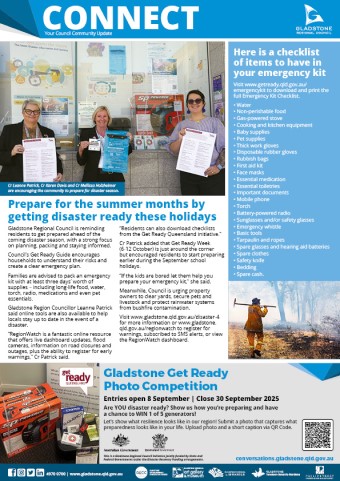
Latest CONNECT News out now
More Information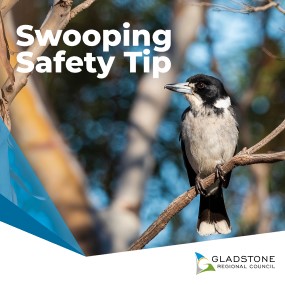
Move in a group to avoid the swoop.
Report swooping birds and other informationGladstone Regional Council
Connect. Innovate. Diversify.
Get in Touch
Phone
(07) 4970 0700
Opening Hours
8.30am - 5pm Monday to Friday
Social media
Postal Address
PO Box 29, Gladstone Qld 4680
Council Offices
101 Goondoon Street, Gladstone Qld 4680
3 Don Cameron Drive, Calliope Qld 4680
41 Blomfield Street, Miriam Vale Qld 4677
Cnr Wyndham & Hayes Avenues, Boyne Island Qld 4680
Rural Transaction Centres
71 Springs Road, Agnes Water Qld 4677
47 Raglan Street, Mount Larcom Qld 4695
Footer Acknowledgement
Gladstone Regional Council would like to acknowledge the Bailai, the Gurang, the Gooreng Gooreng and the Taribelang Bunda people who are the traditional custodians of this land. Gladstone Regional Council would also like to pay respect to Elders both past, present and emerging, and extend that respect to other Aboriginal and Torres Strait Islander people. Learn more about Council's Reconciliation Action Plan (RAP).
Chat Popup
All content © Gladstone Regional Council. All Rights Reserved.
Back to the top


